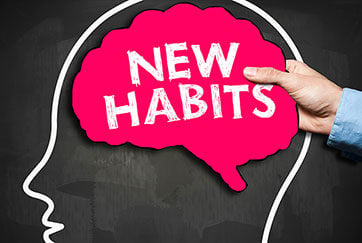
It’s a new year. Usually, that turns into a nation of people reflecting on the past several months and projecting into the future by setting New Year’s resolutions. I have never been a great New Year’s resolution guy. I have the best of intentions, like most people. I start off with so much energy and perceived commitment, but slowly start to drift back into old habits and, before I know it, I am back to my usual routines. I am sure if I took a poll many of you would say the same thing.
Why is that? Why are New Year’s resolutions so hard to keep? How can we make positive changes and turn them into habits?
Most of us have been taught that it takes upwards to 60 days to create a habit. Dr. Susan Weinschenk, author featured in Psychology Today, says this isn’t true. In fact, she shares that most of the habits we have are developed unconsciously and we do them automatically. This not only makes life easier but also frees our brains to focus on other things. Think about that. Have you ever moved into a new house or office? Everything is in a different place. It is overwhelming at first but eventually gets easy as you grow to know (out of daily habitual behaviors) where everything is.
We have lots of habits we do each day:
- How we get to work everyday
- Our morning routines
- How you brush your teeth
- How you load the dishwasher
- Your routine before going to bed or immediately after waking up
- How you start your day at work by turning on the computer or creating a list
The list could go on and on. The big question is how did these things become so automated and how can you automate something that is really meaningful to you that you want to begin making a habit?
Shawn Achor, author of “The Happiness Advantage” suggests that we first try to reduce what is called catalyst energy – the energy needed to just get started. For example, if you want to work out in the morning, reduce all of the obstacles that would keep you from talking yourself out of it when the alarm goes off. One strategy may be to place your shoes by the bed and sleep in your workout clothes. Then all you would have to do is roll out of bed, put your feet into your shoes and off you go!
The opposite is also true. If your goal is to stop doing something, you can create obstacles (increase catalyst energy needed) that will reduce the chances of you engaging in the behavior you are avoiding. For example, if your goal is to reduce the amount of time watching television, you can take the remote, take out the batteries, and place the remote in a room away from the TV and the batteries in another room. The challenge of having to go get the remote and put batteries in it before you can watch your show will expend more time and energy than the value you anticipate getting out of the television show, causing you to not even bother. Place a magazine or a book by the couch and chances are you will pick that up instead!
This new year, I invite you to find a behavior you want to cultivate in your lives – one that will add value and joy. Reflect on how you can reduce and increase the catalyst energy needed to engage in that behavior and take action! The key is to start small and make it as easy as possible. Before you know it, you will be exactly where you want!

